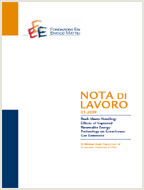Drought Management Plans and Water Availability in Agriculture. A Risk Assessment Model for a Southern European Basin

22.06.2014
Carlos Dionisio Pérez Blanco, Carlos Mario Gómez Gomez
Q1, Q25
Agricultural Economics, Water Economics, Risk Management, Guadalquivir River Basin.
Climate Change and Sustainable Development
Carlo Carraro
The Drought Management Plans (DMPs) are a regulatory instrument that establishes priorities among the different water uses and defines more stringent constraints to access to publicly provided water during droughts, especially for non-priority uses such as agriculture. These plans have recently become widespread across EU southern basins. Shockingly, in some of these basins the plans were approved without an assessment of the potential impacts that they may have over the economic activities exposed to water restrictions. This paper develops a stochastic methodology to estimate the expected water availability in agriculture that results from the decision rules of the recently approved DMPs. The methodology is applied to the particular case of the Guadalquivir River Basin in southern Spain. Results show that if the DMPs are successfully enforced, available water will satisfy in average 62.2% of the annual demand. This is much lower than the minimum water access reliability of 90% that the Spanish law has assured to irrigators so far.
***
Suggested citation: Carlos Dionisio Pérez-Blanco, Carlos Mario Gómez, Drought management plans and water availability in agriculture: A risk assessment model for a Southern European basin, Weather and Climate Extremes, Volume 4, August 2014, Pages 11-18, ISSN 2212-0947, http://dx.doi.org/10.1016/j.wace.2014.02.003
